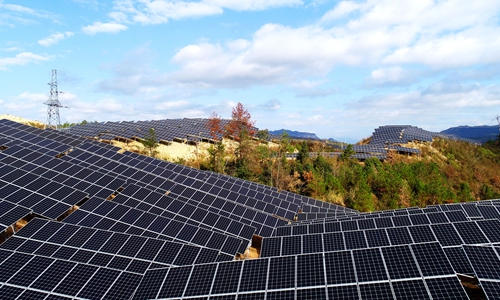Lambasting China as the world’s largest carbon dioxide emitter biased: analysts
Getting clean off coal

A view of photovoltaic panels in Taizhou, East China's Zhejiang Province in December Photo: CNSphoto
China has been rapidly moving away from coal power to cleaner energy in recent years. Some Western media has been biased to disregard such efforts from a responsible nation to slow global carbon emissions and lambast China as the world's largest carbon dioxide (CO2) emitter, Chinese observers said.
The comment follows a string of Western media reports that put a spotlight on China' greenhouse gas emissions and admonished the country's supposed inefficient attempts in combating CO2 emissions.
Some cited a report from environmental website globalcarbonatlas.org and criticized China for emitting the most CO2 globally last year at 10,065 million tons. Also, a report from the Guardian in December compared China's 2.3-percent CO2 emissions growth rate with a 1.7-percent slide in the US.
The US is currently the world's second largest carbon emitter, producing 5,416 million tons of CO2 last year.
Industry insiders have doubted the reliability of the data concerning China in the report, with some pegging the results of China's emissions as being miscalculated or even inflated.
"China has been stepping up its push into renewable energy from coal-fired power to cap CO2 in recent years. Without the ongoing action, China's CO2 emissions could be driven by 30 percent to 40 percent higher from the current level," Lin Boqiang, director of the China Center for Energy Economics Research at Xiamen University, told the Global Times.
In 2018, coal accounted for 59 percent of China's total energy consumption, marking the first time coal accounted for less than 60 percent of primary energy, according to data from the National Bureau of Statistics (NBS). Energy generated from renewable energy sources accounted for 26.7 percent of total power output in 2018, NBS data showed.
Just seven years ago, coal represented over 70 percent of China's total energy consumption.
Chinese authorities have yet to release any official data on the nation's greenhouse gas emissions. But comments from Chinese officials offer a glimpse on how the country has committed itself to addressing climate change and steadfastly delivering its international promises.
Zhao Yingmin, vice-minister of ecology and environment, said at a press briefing in November that China has slashed the amount of carbon emissions per unit of GDP by 45.8 percent from 2005 levels, meeting the target of at least a 40 percent decrease by 2020 ahead of schedule.
The figure equates to a reduction of 5.26 billion fewer tons of carbon dioxide emitted in China since 2005. In contrast, the US Energy Information Administration estimated that US energy-related CO2 emissions only declined by 861 million tons from 2005 to 2017.
When it comes to CO2 emissions per capita, other countries bear more responsibility than China.
For example, the average Chinese was responsible for about 8 tons of CO2 in 2018, while US emissions stood at 16 tons per person, according to a Forbes report.
Climate comparisons
Lin stressed that it's unfair to compare China's CO2 emissions with that of developed nations such as the US, a common tactic that some Western media adopts when distorting China's battle against greenhouse gases.
"Due to the differences in energy structure between China and the West as well as in the purchasing ability of clean energy, meager efforts from the US and lavish actions in China could produce a similar change in CO2 emissions," Lin explained.
Analysts noted that for the sake of an equal footing, it is more logical to compare China with other developing nations such as India.
India ranked as the third-largest emitter of CO2 in the world, producing 2,654 million tons of CO2 in 2018, up 4.8 percent year-on-year, according to the globalcarbonatlas.org report.
The South Asian country's CO2 emissions are growing at a faster rate than any other emerging economy, the report showed.
"Coal will still be the mainstay of Indian economy for a pretty long time as Indian government is grappling with the issue of how to expand clean energy technologies. It is obvious that China's efforts in cutting CO2 emissions outstrip that of India," Lin noted.

